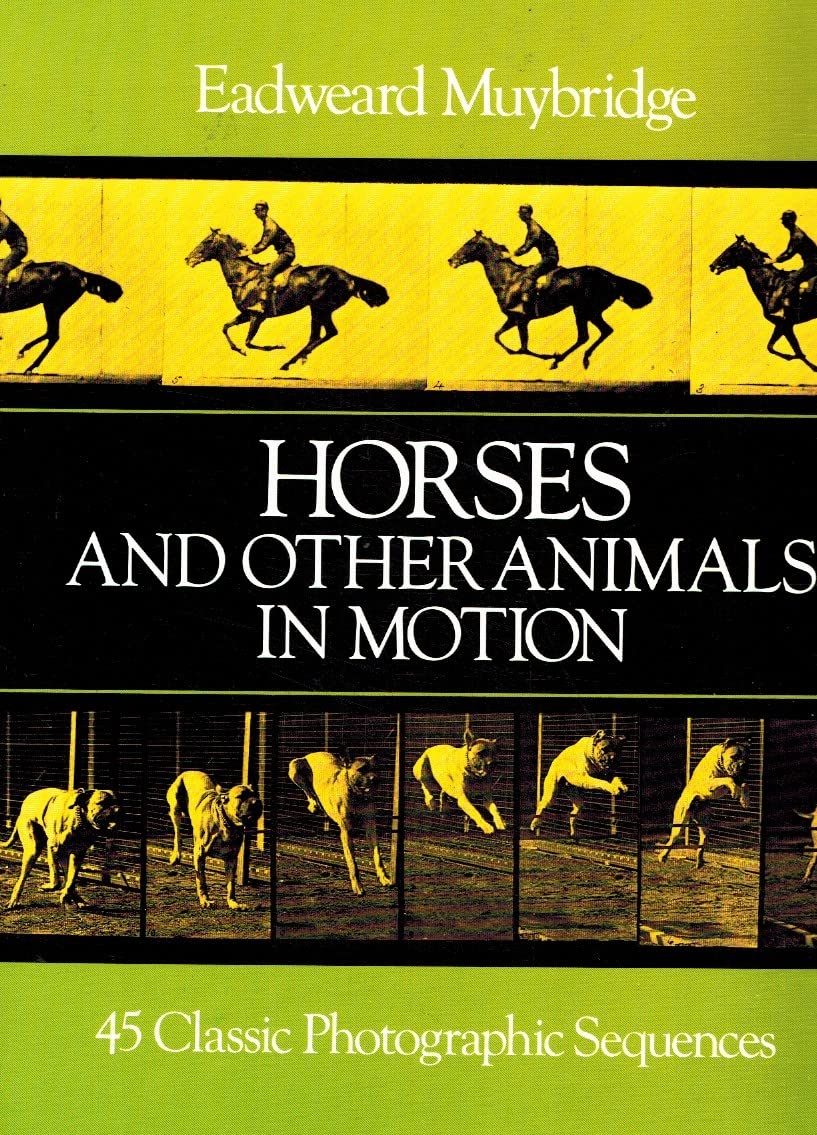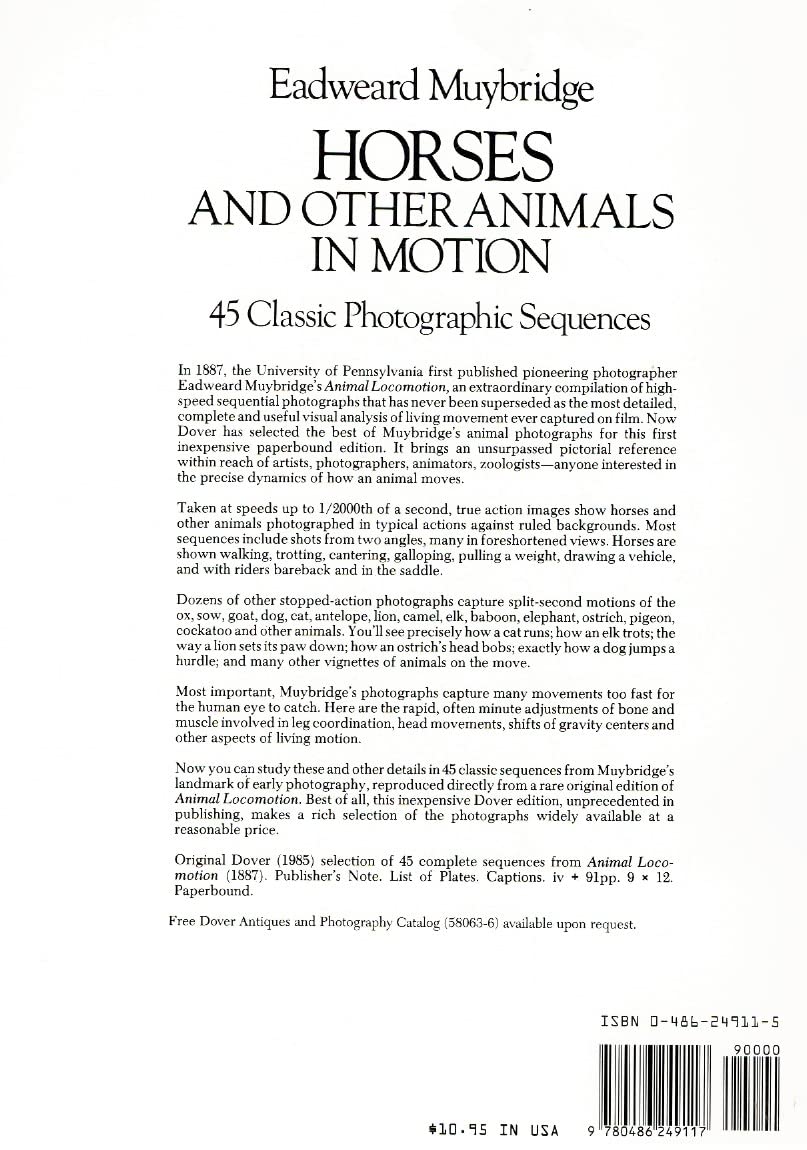In 1887 the University of Pennsylvania first published Animal Locomotion by pioneering photographer Eadweard Muybridge, an extraordinary compilation of high-speed sequential photographs that has never been superseded as the most detailed, complete, and useful visual analysis of living movement ever captured on film. Dover has selected the best of Muybridge’s animal photographs for this inexpensive paperbound edition. It brings an unsurpassed pictorial reference within reach of artists, photographers, animators, zoologists, and anyone interested in the precise dynamics of how an animal moves.
Taken at speeds up to 1/2,000 of a second, true action images show horses and other animals photographed in typical actions against ruled backgrounds. Most sequences include shots from two angles, many in foreshortened views. Horses are shown walking, trotting, cantering, galloping, pulling a weight, drawing a vehicle, and with riders bareback and in the saddle.
Dozens of other stopped-action photographs capture split-second motions of the ox, sow, goat, dog, cat, antelope, lion, camel, elk, baboon, elephant, ostrich, pigeon, cockatoo, and other animals. You’ll see precisely how a cat runs; how an elk trots; the way a lion sets its paw down, how an ostrich’s head bobs; exactly how a dog jumps a hurdle; and many other vignettes of animals on the move.
Most important, Muybridge’s photographs capture many movements too fast for the human eye to catch. Here are the rapid, often minute adjustments of bone and muscle involved in leg coordination, head movements, shifts of gravity centers, and other aspects of living motion.
Now you can study these and other details in 45 classic sequences from Muybridge’s landmark of early photography, reproduced directly from a rare original edition of Animal Locomotion. Best of all, this inexpensive Dover edition, unprecedented in publishing, makes a rich selection of the photographs widely available at a reasonable price.
Taken at speeds up to 1/2,000 of a second, true action images show horses and other animals photographed in typical actions against ruled backgrounds. Most sequences include shots from two angles, many in foreshortened views. Horses are shown walking, trotting, cantering, galloping, pulling a weight, drawing a vehicle, and with riders bareback and in the saddle.
Dozens of other stopped-action photographs capture split-second motions of the ox, sow, goat, dog, cat, antelope, lion, camel, elk, baboon, elephant, ostrich, pigeon, cockatoo, and other animals. You’ll see precisely how a cat runs; how an elk trots; the way a lion sets its paw down, how an ostrich’s head bobs; exactly how a dog jumps a hurdle; and many other vignettes of animals on the move.
Most important, Muybridge’s photographs capture many movements too fast for the human eye to catch. Here are the rapid, often minute adjustments of bone and muscle involved in leg coordination, head movements, shifts of gravity centers, and other aspects of living motion.
Now you can study these and other details in 45 classic sequences from Muybridge’s landmark of early photography, reproduced directly from a rare original edition of Animal Locomotion. Best of all, this inexpensive Dover edition, unprecedented in publishing, makes a rich selection of the photographs widely available at a reasonable price.
Read more
28 reviews for Horses and Other Animals in Motion: 45 Classic Photographic Sequences (Dover Anatomy for Artists)
Show all
Most Helpful
Highest Rating
Lowest Rating
Add a review

Horses and Other Animals in Motion: 45 Classic Photographic Sequences (Dover Anatomy for Artists)
$15.98





D Fellini –
Classic and wonderful book, but it arrived with a torn cover, so I returned it. Some problems arranging for collection of faulty items, but got there in the end. The pre-arranged hour came and went, but no knock at the door, so had to arrange another day. Never a problem delivering! Is there some attempt to persuade us all to use “Collection Points”?
jen –
I bought this because a friend of mine had it. Her version must have been the full version because it was an inch thick with a lot of text.
This book is ONLY the pictures without the text so it’s a lot smaller (and lighter) and since I’m using this as drawing reference all I need are the pictures!
Beanster –
~This is a very useful book if you are an artist or sculptor as is shows the movement and bone structure of many animals.
Melanie C. –
This out of print book is a classic for analyzing the movements of many different animals. My copy arrived with several tears but few other signs of wear. If new this book would have been five stars. It is an awesome book and I am delighted to have it in my collection. This seller shiped promptly.
Jo Richardsin –
Excellent book but some pages stuck together that are damaged, seemed to have got wet somewhere?
Luckily not the photos damaged.
Suzanne Thom –
As Advertised As Advertised As Advertised As Advertised As Advertised As Advertised As Advertised As Advertised As Advertised As Advertised As Advertised
David Thomas II –
For those of you who are 3d animators this book is great, it really helps to know how to truly make lifelike those horses or other animals that are more complex then bipeds. I recommend this book to all.
[email protected]
Moira B –
Not as detailed as I had hoped for however I know that I will get a lot of use from this book.
Mrs. Alice S. Franceschini –
I had heard about these books and I wanted one to look at. It is a good starter book for showing animal movements for animation purposes.
Cindy Westbrook –
Muybridge is the standard and a classic. It is amazing what he accomplished in his time period. A great reference.
Atticus –
The 45 sequences in Horses and Other Animals are included in the larger Animals in Motion by Muybridge. The difference being that in Animals, you get more sequences and usually better reproductions; in Horses and Other Animals you get fewer sequences, but larger images making the detail a little more visible – except in those cases where the reproductions are a little gray and washed out. You choose – more and better or fewer and more gray. You don’t really need both books.
cricri14 –
i love this study
the ed muybridge work’s is unique, magic, incredible…
the history teach us….every day, every night, every moment of life!